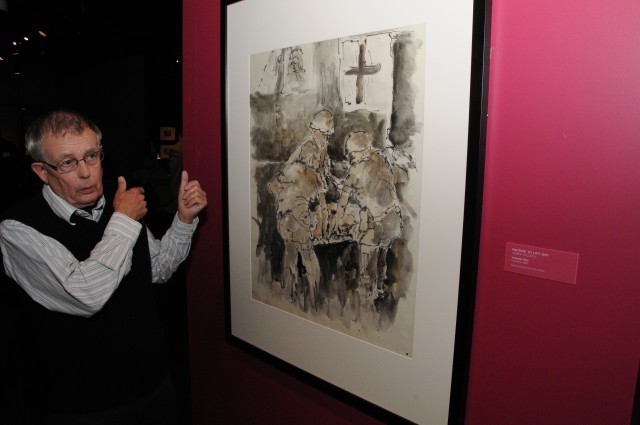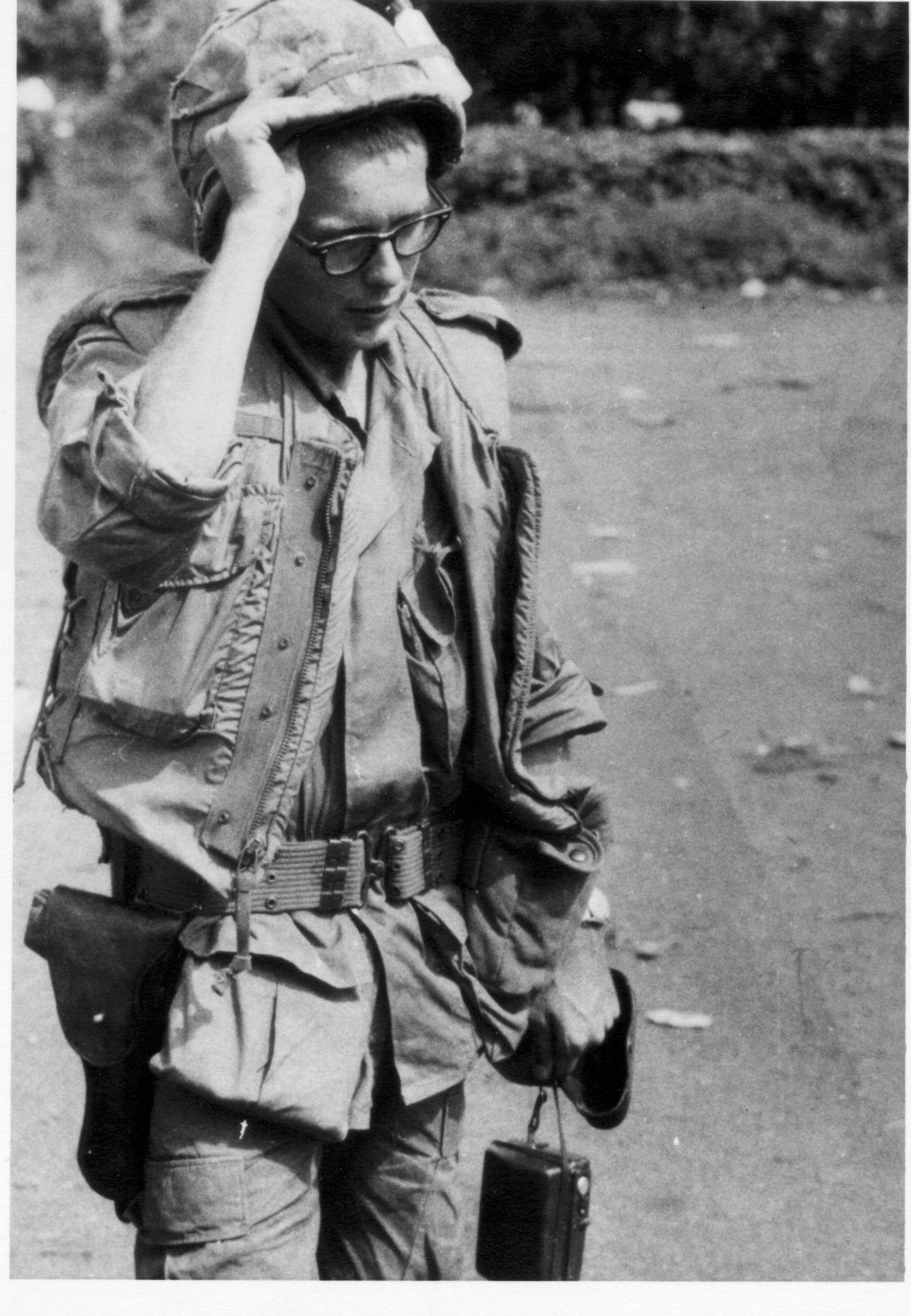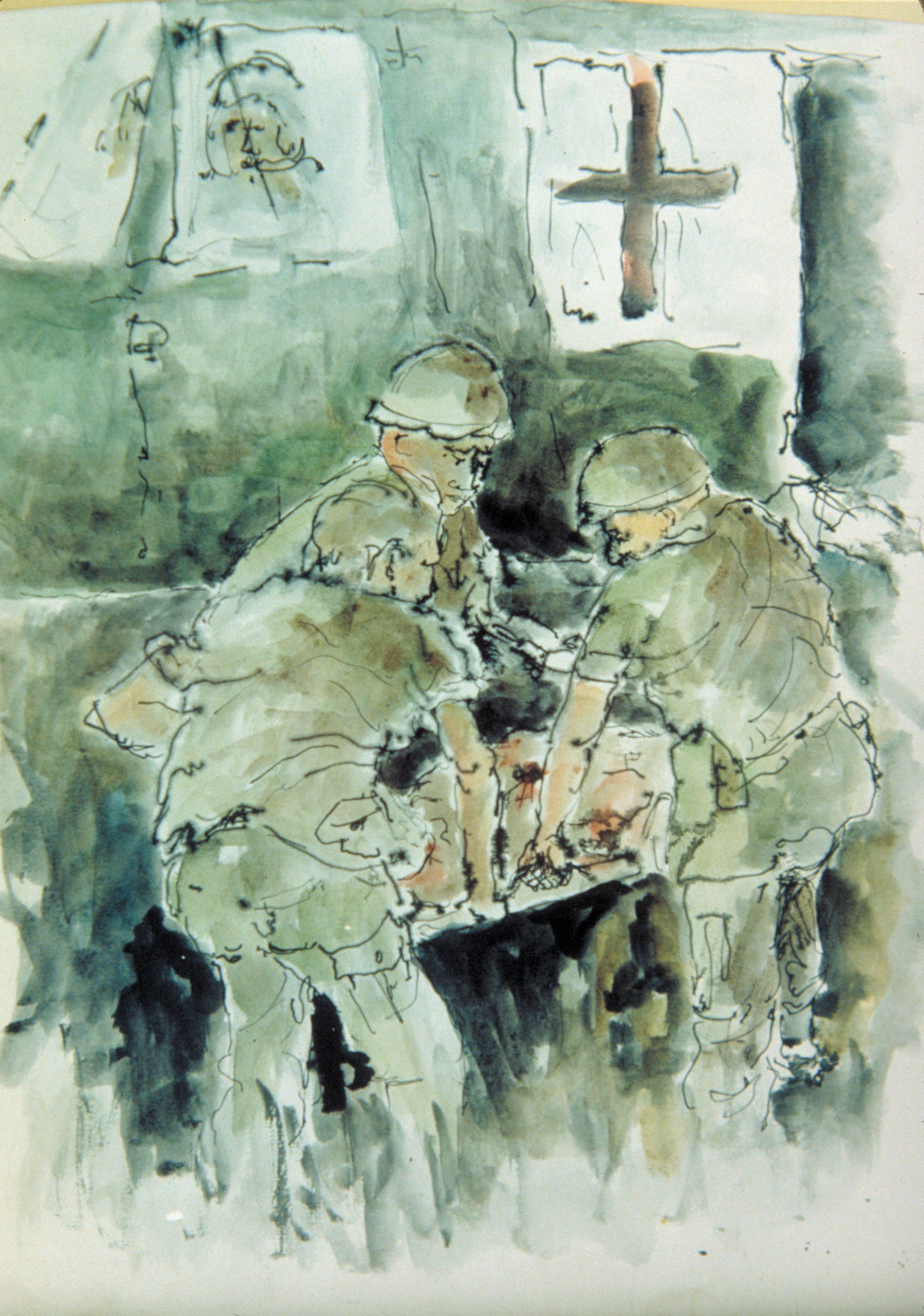Warm spotlights highlighted an array of unique artwork while the rest of the world faded into the shadows. Museum patrons strolled through the display, catching a glimpse of Soldier life.
"It's my job to capture history," said Master Sgt. Martin Cervantez, and he does so, skillfully.
Cervantez, currently assigned to the Center of Military History, paints for a living. He has deployed to Afghanistan and Iraq, where he observed Soldiers in the field to create moving, vibrant works of art.
Cervantez's works, along with pieces from other Soldier-artists throughout Army history, are on display at the National Constitution Center in Philadelphia. The Art of the American Soldier exhibit, which opened Sept. 24, features about 250 pieces from the Army Art Program collection that depict the everyday lives of Soldiers, from barracks to combat to sick call.
Combat art like Cervantez's was created through the initiative of the individual Soldier until World War I, when the Corps of Engineers commissioned eight artists to capture the activities of the Army and the Soldiers who filled its ranks, according to the National Constitution Center.
The War Art Unit was established in early 1942, and grew to 42 artists-23 active-duty, 19 civilian-by the spring of 1943. At the end of World War II, the Army's art collection had grown to more than 2,000 pieces, managed by the War Department Art Committee.
The Korean War was not documented officially, but artwork has been created from photographs, purchased or donated.
The Army Art Program was born from these earlier programs in 1965 at the request of the chief of military history, and was originally called the Army Combat Art program. The program sponsored 46 Soldiers, who served four- to six-month tours in Vietnam from 1966-1968. Artists sketched and photographed images of the war then returned to the studio to produce paintings from those preliminary pieces, according to the NCC.
Jim Pollock, part of the fourth combat art team in Vietnam, served as a postal clerk in Korea before discovering the art program and submitting an application, he said.
"We had open travel orders, so we'd go visit different types of units," Pollock said of the combat art teams. He described the Soldier-artist's duties as similar to what modern embedded reporters do today.
"We really had a lot of freedom to do what we wanted," he explained.
That freedom allowed him to select the kinds of activities he wanted to portray: day-to-day combat hardships.
"The things (Soldiers) had to endure were really quite physically demanding," Pollock said. "I would go in there and I would spend a day or two days with them, and then I could fly out again. I always felt sorry because these Soldiers had to be there, day in and day out."
Pollock's painting, "Waiting to Lift Off," which is featured in the exhibit, is created from his experiences in the field and at a hospital. Originally painted with India and colored inks, the color has faded from the piece, leaving a black and white sketch of Soldiers preparing a wounded man for his flight in a helicopter.
"What I try to get across to the viewers of the art that I do is to show, in as honest a way as I could, what kinds of hardships the Soldiers endured in Vietnam," Pollock said.
During the grand opening of the exhibit, the lobby of the NCC transformed into a World War II-era USO canteen, complete with a Bob Hope impersonator and the Liberty Bells, a women's vocal group. Student tour groups from Philadelphia and North Carolina overwhelmed the exhibit.
Tony Storch, a history teacher and designated chaperon with the Caldwell Academy from Greensboro, N.C., thought the exhibit was fantastic:
"Personally, I really enjoy it," Storch said. "I feel like it will help the students relate better to the history that the country has gone through."
"I'm really happy we could see this, and I would like to lay my hands on a book or some DVDs and bring it back to the classroom," Storch added.
Roger Blum was another Vietnam combat artist featured in the exhibit. Drafted in 1965 right after his honeymoon, Blum tried to portray his feelings about seeing Soldiers at work in the field through color and drama.
"Many times I would see things happening, and I would come back to my camp. I would sketch ideas that I remembered and (that) I thought would dramatize my experience that day beyond paint and pencil," Blum said.
Though Blum doesn't feel his technical ability was as good as others, he believes the emotional application in his paintings makes them stand out and speak to the audience. He said he is honored to be a part of the exhibit.
"I have to admit that this whole art program has gone beyond whatever I thought it would be," Blum said. "I'm very honored that we have this opportunity to see other art work as well, because I haven't seen much of it myself."
"I love seeing the war from the Soldier's perspective," Anna Bishop, a student at Caldwell Academy, said. "How they're feeling, and how they portray that through art."
Students from the Charter High School for Architecture and Design in Philadelphia agreed, adding that going through the exhibit was enlightening, because they didn't know anyone affiliated with the military.
In addition to art from past wars, the exhibit highlighted works from more current conflicts, to include the wars in Iraq and Afghanistan. Cervantez, one of the contemporary artists, has four pieces in the exhibit.
Cervantez, a visual information operations chief, has been drawing since he was a young man, taking art classes all through school and learning from other established artists. He said he wants to return to Afghanistan and capture Soldiers' day-to-day activities.
Cervantez's paintings have a vibrant color palette because the lighting conditions in Afghanistan are so bright, he explained. The heavy sun brings out many colors in the landscape there. He tries to portray the uniqueness of the environment and the complexity of the situations that Soldiers find themselves in through his use of color.
"I tend to choose subjects, or subject matter and elements in the painting that aren't necessarily unit specific or job specific, but stuff that everybody does," Cervantez added. He hopes the paintings will be universal, both for military members and for non-military.
"Being the first time this (exhibit) has been brought to the public in this capacity, I hope it brings a (greater) awareness to the type of work that is out there, or that's been done already," Cervantez said. "Hopefully, more Soldiers will contribute, and more Family members that have Soldier-art will contribute."
David Eisner, chief executive officer from the NCC, called the exhibit "the most famous collection nobody has ever heard of," and hopes that visitors will be able to take away a sense of what life is like for Soldiers.
"We hope that visitors will leave the center with gratitude for (the Soldiers') service," Eisner said.
The Art of the American Soldier exhibit is open through Jan. 10, 2011, and veterans and military Families receive a discount on museum admission. For more information on the exhibit visit <a href="http://www.constitutioncenter.org/ArtOfTheAmericanSoldier/">www.constitutioncenter.org/ArtOfTheAmericanSoldier</a>






















Social Sharing